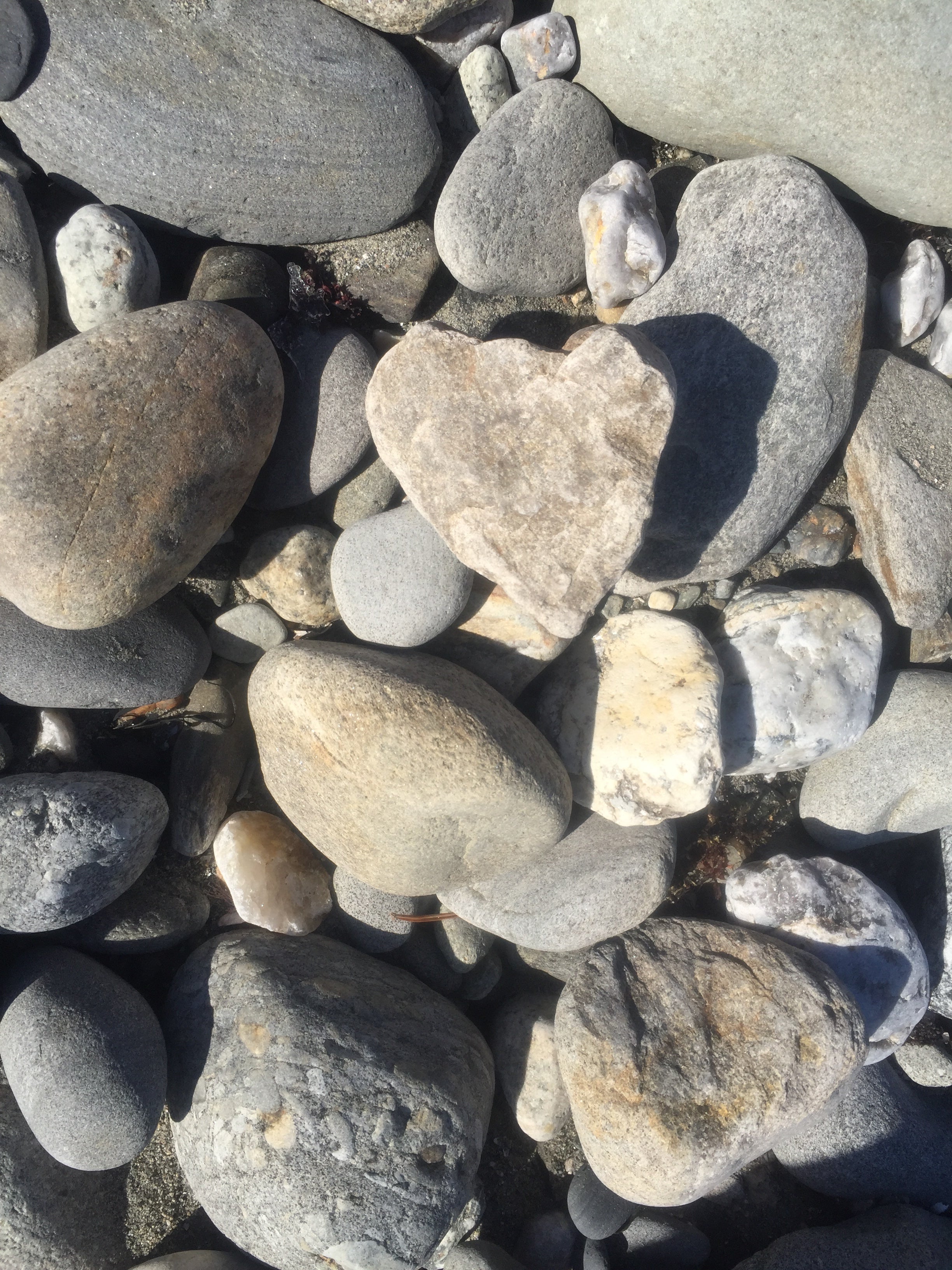February has Valentines Day and is American Heart Month so it’s certainly the month when you can wear your heart on your sleeve. In that vein, here is my winter and spring “Favorite Five” list of what makes the University of Rhode Island’s Graduate School of Oceanography (GSO) so special and why we “heart” GSO. Look for the summer and fall Favorite Five (B)log in April.
- Chowder and Marching Society
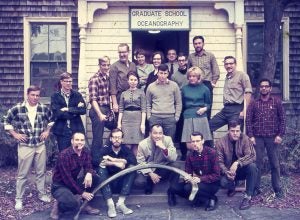
This GSO student organization has been around since soon after students arrived on campus in 1961, but how it got its unusual name is a bit of a mystery. The term “Chowder and Marching Society” was probably first used as the name of social groups that met to talk over beers within the New York City political organization Tammany Hall that started in 1789, according to Michael Pilson, GSO emeritus professor. The name became popular as a result of a comic strip in the 1940’s called “Barnaby” that had a fraternal organization called “Elves, Leprechauns, Gnomes, and Little Men’s Chowder & Marching Society.”
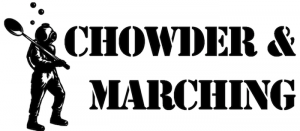
“I have assumed that some student during the early 1960s here, with a taste for whimsy, picked up on the name to use here for an organization where the students would drink beer and talk,” said Michael Pilson. Sheldon Pratt, who was a student in GSO’s first class in 1961, agrees with Michael and thinks it was Don Lear, a student of John Sieburth, who received his Ph.D. in 1965. Candace Oviatt and Don Gordon, who were also GSO students at the time, concur. Michael continues “The group then became the place to go to get student opinion, or to mobilize students for some activity. It was regularly consulted by Dean Knauss to get student reaction to some plan or other.”

This continues to the present day. For example, the current President, Victoria Fulfer, served on the committee selecting the name of the new research vessel. The group remains very active, organizing community service events such as Christmas gift collections, and Thanksgiving food drives, in addition to student social events such as the Chili Cook Off, fall hayrides, sports tournaments, and the Boat Burning. But alas no marching activities. Maybe they need to start a chowder competition, to live up to their name.
- The Harpoon Seminar
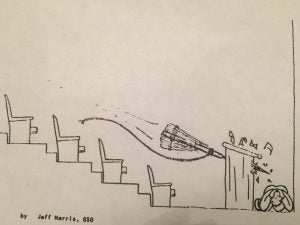
In early 1979, Neil Ross, who worked at GSO as an Extension Specialist for the Sea Grant Marine Advisory Service hatched an idea to bring some levity to GSO on April Fool’s Day with a special “Harpoon Seminar.” It appeared to be a typical seminar, but as it progressed, his work on marinas and tire floats seemed more and more outrageous. The audience, which filled Corless Auditorium, loved it. After the second Harpoon Seminar, Neil decide it was best to leave the country and so GSO graduate students Walter Berry (now working at the EPA lab across the street) and Bob Sand (now manager of the GSO Computer Center) took over and continue the tradition to this day. They put out a call for presentations, serve as Masters of Ceremonies, and sometimes give presentations.
What is the Harpoon Seminar? It takes place on April Fools’ Day at noon (or the Monday or Friday if the 1st falls on a weekend) in Corless Auditorium and is a series of four to five presentations that spoof our science. The presentations may be a scientific seminar with real data on an unlikely topic, such as GSO emeritus professor Michael Pilson’s tracking of field mice caught in his house and released at varying distances away (and returning again and again) or GSO student Rich Appeldoorn’s seminar on increasing incidence of cancer in clams, relating it to the use of clam shells for cigarette ash trays, and measuring it with “bioashtrays.” Sometimes a GSO custom, such as having a poster with photos of each student in each incoming class outside the Academic Affairs Office, is mined in an oceanographic way, such as when GSO students Bill Miller and Whitney King talked on “the Phenotypic Study of GSO Students as recorded by Office Paleophotographic Record.” Or the presentation might be totally different, such as the year former GSO Professor Brad Moran started out a presentation in his suit and tie and talking about funding challenges but then the lights went down and he picked up his electric guitar and commented about scientific funding with his own lyrics to “Knocking’ on Heaven’s Door,” as covered by Gun’s & Roses, called “Knocking’ on NSF’s Door”:
“Momma said son, get a degree
Start with Bachelor’s, and maybe a PhD
Finish a post-doc, then a real job
And I’m still knocking on that door
Knock Knock Knock on NSF’s door
Knock Knock Knock on NSF’s door”
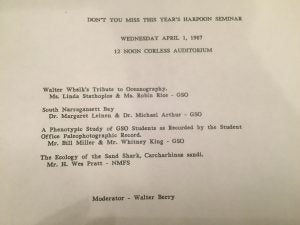
Courtesy R. Sand
The GSO Administration has taken part several times in the Harpoon. Founding Dean John Knauss spoke on “Lessons Learned from 25 years of Monday Afternoon Student Seminars.” Dean Margaret Leinen remembers the year her staff “gave a Harpoon Seminar that focused on revenue production. The campus laughed with us at the suggestion that we advertise on the hull of the R/V Endeavor and convert the Bay Campus into a golf course.”
The URI Administration has even taken part, for example the year that URI President Ted Eddy jumped out of the audience singing the “South Pacific” song, “I’m Gonna Wash that Man Right Outa My Hair” as a good bye to Dean John Knauss on his stepping down as GSO Dean in 1987. That was part of a “South Narragansett Bay” (instead of South Pacific) sketch put on by Margaret (before she was dean) and fellow GSO professor Mike Arthur.
The Harpoon even made the Providence Journal when their science writer Eugene Emery attend the seminar and highlighted Walter Berry’s talk about “Narrie,” the Narragansett Bay version of the Loch Ness monster, in the newspaper.
This year will be the Harpoon’s 40th Anniversary, so it’s sure to be the best one yet, don’t miss it! Noon on April 1st at Corless Auditorium – get there early to get a seat!
- Narragansett Bay Blades
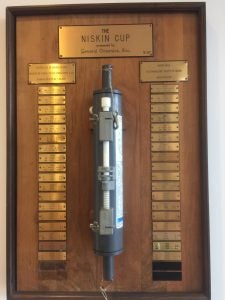
Ever wonder why there is a Niskin Bottle on a plaque on the wall in GSO’s Nautilus Café Back in 1978, a group of GSO faculty, staff, and graduate students who liked to play hockey entered a team in a hockey league at the ice rink at St. Georges School in Newport. In 1981, they found out Woods Hole Oceanographic Institution also had a hockey team, the WHOI High Stickers, and an oceanographic, cross-state rivalry with the Narragansett Bay Blades began. The teams play two games a year, one at Woods Hole and one at URI. Graduate students, alumni, faculty, and staff make up the teams, and alumni have been known to return from far off institutions to play in the games. In order to ensure that there are no “ringers” brought in to play and that each player is an oceanographer, each team member must set and trip the Niskin bottle. The inventor of the Niskin bottle, Shale Niskin, heard about the rivalry and the unique method of proving their oceanographic worth, and donated a Niskin Bottle as the trophy.

The coveted Niskin Cup is the trophy seen in the café – a still functioning Niskin bottle mounted to a wooden plaque with brass plates for the score of each game. Each year, the goals of the two games are tallied up and the team with the most goals gets to keep the plaque for the year. GSO was the highest scorer last year, so the plaque is in the Café right now. Games are held on Saturdays in March or April and are followed by a pot luck gathering. The GSO hosted games are held at URI Boss Ice Arena and the dinner afterwards is held at the Mosby Center. Although the two teams are fierce competitors on the ice, off the ice they are good friends and the dinners are great fun. This year’s home game will be Saturday April 6, come out and cheer on our favorite team! Watch the GSO Facebook and Twitter accounts for game reminders. The full roster and lots of photos can be found here.
- Dog Memos from the Dean
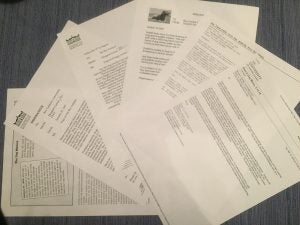
As any GSO dean knows, you are not truly the dean until you have sent your first dog memo. Interim Dean Jim Yoder wrote that he was “extremely excited by the opportunity to write this note.”
So what’s a Dog Memo? The Bay Campus is a beautiful place to walk or jog and after (or before) working hours many people are known to do just that and have their dog with them. But by state law, dogs are not allowed in state buildings. The dog immigration starts slowly. Someone sneaks their dog in on weekends. Someone else slips their dog in after lunch. Next thing you know, there are dogs running across the quad at all hours. There are complaints by researchers. There is a plea by the custodial staff for the Dean to issue a new memo. And then we get the all-campus email with the dog memo, saying “please keep your dog at home” and the Dean has to mention how much he/she really loves dogs but just not on campus during work hours. Dean Knauss issued the first dog memo in January 27, 1972 and every dean and interim dean has written at least one.
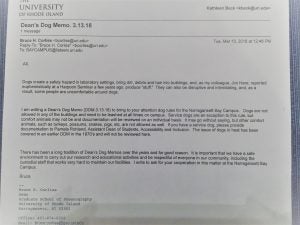
Before writing a new Dog Memo, most Deans have reviewed the file of Dog Memos, which really does exist, thanks to Kathy Beck, Executive Assistant to the Dean and her predecessors. To quote from many Dean Dog Memos “There are no new reasons, only new memos”. The Deans are often creative with ways to get their message across. As Dean Margaret Leinen said, “Please do not bring your dogs to the campus, we cannot give them degrees and they don’t pay tuition.” Of course, the memos have to keep up with the times. In 2018 Dean Bruce Corliss noted that service animals and comfort dogs with proper documentation, will be reviewed on an individual basis but comfort “turkeys, possums, snakes, pigs, etc.” are not allowed. It’s been almost a year since the last dog memo, are we due for another?
- GSO Benches and Trees of Honor
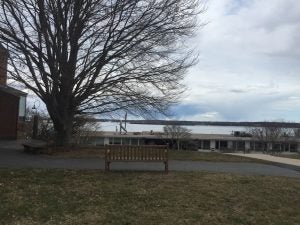
We should all love that GSO recognizes people with strong ties to the school with a bench. Many are on the Knauss Terrace or Quad, but others are on scenic spots around campus. Each bench is a place to sit and think about the person it is dedicated to, or just enjoy the view. You can rest after that long walk up the hill on South Ferry Road and you can share it with someone else and have a conversation overlooking Narraganset Bay. The newer benches have plaques with a few words about the person it is honoring. If you don’t know the person, or if its ten years hence and some new graduate student sits on the bench, they can learn about this person who was dedicated to GSO.
There are also a few trees on campus that were planted in honor of a GSO person who passed away. This isn’t done anymore because the trees can’t be moved if the space is needed for something else but it is nice to see these trees growing and thriving, a reminder of people in GSO’s history.
There’s my GSO Favorite Five for winter and spring. Did I forget some of your favorites? Email me at vmberounsky@uri.edu.
February 25, 2019 , Volume 2, Number 1
The author would like to thank Donald Gordon, GSO ’64 for access to his not yet published manuscript “EARLY YEARS AT THE GRADUATE SCHOOL OF OCEANOGRAPHY (1962-1965)”, Walter Berry and Bob Sand for access to Harpoon Announcements, Margaret S. Leinen for excerpts from Navigating the Lean Years at GSO, Maritimes Spring 2000 issue, and Kathy Beck for access to the GSO Dog Memo file.
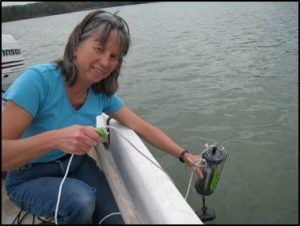 This blog post was written by Veronica M. Berounsky, GSO Science Correspondent and Coastal Ecologist. She first arrived at GSO in March of 1979 as a research lab tech. In 1990 she obtained her Ph.D., working on nitrification in Narragansett Bay with the late Scott W. Nixon. She continues to be fascinated by the ecology of coastal ecosystems every day. With this blog she hopes to increase your understanding of the activities and people of GSO and the Narragansett Bay Campus. Please email any comments to her at vmberounsky@uri.edu.
This blog post was written by Veronica M. Berounsky, GSO Science Correspondent and Coastal Ecologist. She first arrived at GSO in March of 1979 as a research lab tech. In 1990 she obtained her Ph.D., working on nitrification in Narragansett Bay with the late Scott W. Nixon. She continues to be fascinated by the ecology of coastal ecosystems every day. With this blog she hopes to increase your understanding of the activities and people of GSO and the Narragansett Bay Campus. Please email any comments to her at vmberounsky@uri.edu.
Click here to see all previous Bay Campus (B)logs.
Subscribe to the Bay Campus (B)log here

